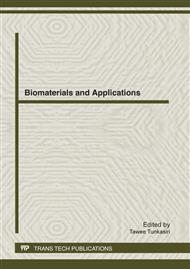p.375
p.381
p.385
p.389
p.393
p.397
p.401
p.405
p.409
Chemical Composition of Essential Oil and Antioxidant Activities of Curcuma petiolata Roxb. Rhizomes
Abstract:
Pulverized rhizome of Curcuma peliolata on hydrodistillation, afforded light yellow essential oil in the yield of 0.13% v/w. The chemical constituent of the essential oil was determined by GC-MS. Nine compounds representing 95.34 % of the total oil were identified. The major compounds of the oil were 2-methyl-5-pentanol, 1H-pyrrol-1-amine,2-(4-methoxyphenyl)-n,n,5-trimethyl, and curcumol. The distillated aqueous was extracted with dicloromethane (DCM), ethyl acetate (EtOAc), and n-butanol. The DPPH radical scavenging and reducing power of the extracts were investigated. Curcumin and ascorbic acid were used as standard references. The DPPH radical scavenging activity was decrease in order: curcumin ascorbic acid EtOAc extract > DCM extract > n-butanol extract > aqueous extract. The EtOAc extract showed significantly highest inhibition of the radical scavenging activity with IC50 0.092 ± 0.001 mg/mL (curcumin and ascorbic acid (IC50 0.012 and 0.013 mg/mL, respectively (P<0.05)). While, the DCM extract showed highest reducing power with IC50 = 0.271 mg/mL which lower than that of standard curcumin (IC50 = 0.013 mg/mL) and ascorbic acid (IC50 = 0.002 mg/mL).Introduction
Info:
Periodical:
Pages:
393-396
Citation:
Online since:
April 2012
Keywords:
Price:
Сopyright:
© 2012 Trans Tech Publications Ltd. All Rights Reserved
Share:
Citation:


